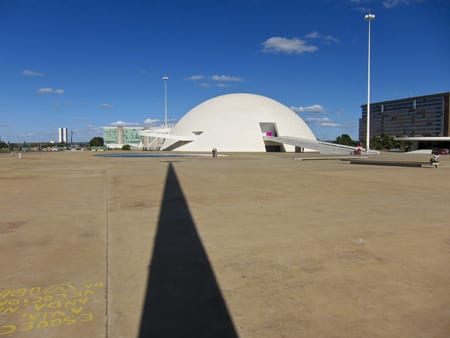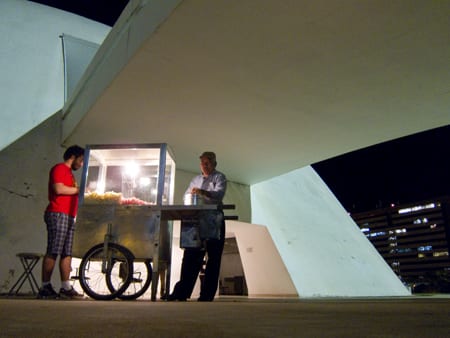By Daniel de la Calle
Brazilians do not like Brasilia, Brasilienses do. I guess it must be the LA of the Southern Hemisphere.
Brasilia was conceived after a dream, but some think of it as a vision, even see it as a prophecy. In the mid 18th century some Salesian priest in Italy (!) prophesied a new civilization would emerge in Brazil, somewhere between the 15th and 20th parallels. Unsurprisingly, that left the country’s ego in quite a healthy state and ruminating on some preexisting ideas about creating a new capital. President Juscelino Kubitschek finally decided in the 50s that the time was then and that is the simple explanation to how one of the most chaotic, improvisational and unreliable countries and societies in the world embarked on building the most orderly and German/Swiss, square, almost robotic, capital ever conceived and constructed. Of course, in order to make the enterprise absolutely maddening, mythical and megalomaniac the project had to be fulfilled from scratch in less than four years and in the middle of the “Brazilian savannah”, the already dream-like looking Cerrado. As a consequence of this a big portion of the expense of building Brasilia came from having to fly all the materials to the chosen spot while the roads were built.
The city is vast, open, beautiful, inhumane, majestic, in decay. It is like an architectural theme park (or more like a rendering of Oscar Niemeyer’s brain), a vision that once was considered futuristic, never got to really be seen as contemporary and now is radically retro (I call it “the future that never was”). Which explains why it is at the same time fascinating, gorgeous and repulsive, something that in my sick mind translates as addictive.
The smooth concrete is cracking after 50 repetitions of six months of rain and six of sun. It is not so white or gray any more, some portions have fallen like breadcrumbs, sections of stained glass in the buildings, churches and cathedral are gone; the endless lawns are a battlefield where nature fruitlessly tries to claim some of its territory back: there is an army of ants with weed-wackers, leaf blowers and helmets, so things still look smooth, open. Here the car is king and pedestrians just lonely antelopes ready to be torn and devoured by bumpers and wheels, with nowhere to hide or to even find shade. Wonder how many Brasilienses walk to work.
Distances are so great and the extreme logic of the layout of streets, street “names”, blocks and buildings so perfect that the mind cannot cling on to any crevice, any irregularity in this absurd maze of letters, numbers and things that look the same but are miles away from one another. Was I already here? Am I supposed to be here? Where was I going anyway?
55 years ago there was only bush, not a soul or building. Now there are thousands of miles of roads, two huge artificial lakes and officially about 3 million people, but I think we can quietly double that figure.
The two times I have come to Brasilia the air was incredibly clean and dry. Because of the altitude and latitude there is an marvelous quality to the light. The colors seem over saturated and the skies are the most spectacular in the world. If you ever go to Brasilia, please do so in the dry season and do not forget your polarized sunglasses. It is one of the most photogenic places I have been to, makes me wish I was a fashion photographer.
I paid little attention to Ana Arruda when two months ago she told me that she was trying to set up the screening at the Museu Nacional. A name is a name and only when I was in Brasilia I started wondering if the Museu Nacional was THE Museu Nacional. It turned out it was and I felt a bit overwhelmed to be in such an iconic space with the film. The Museu Nacional was only built in 2006, but because it came out of Niemeyer’s brain it seems as if it was done together with the rest of the monumental area.
Freaked out by a less than successful experience in Fortaleza a few days before we embarked in a 24 hour promotional tour where we contacted and harassed everyone we knew, sent emails left and right, spoke to newspapers and websites and begged guys at surf shops to come to the screening. Ana had done an incredible and generous job and the power of the internet really shone that evening. I guess in every trip there is a defining time, a lasting image, in every life a sweet moment of success. The place where I laid my first perfect and round egg was Brasilia. Here it is for you to see (I am so proud), the egg:

Not only was the space great, the projector fine, the sound fantastic, but we also had a more than full house with people sitting on the floor. Oh, I get emotional just remembering it. Victory! People applauded enthusiastically, almost everyone stayed for the loooooong batepapo (chat, q&a) and the questions were good, the talk smooth and poignant. We were at the nation’s capital and I was fully aware that it was going to be the best night in the whole tour, so I enjoyed it “live”. The Museu Nacional belonged to A Sea Change for one night.

“Future, future, looks are all that matters”… but people still live here. And where there are people and movies are shown there has to be some popcorn (pipocas). We are so similar to chickens after all.

And a link to Francisco Neto’s blog, who attended the screening:
http://sustenteconsciencia.blogspot.com/2010/04/mares-acidos.html


